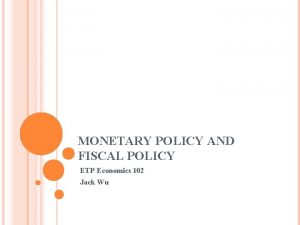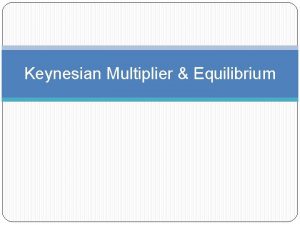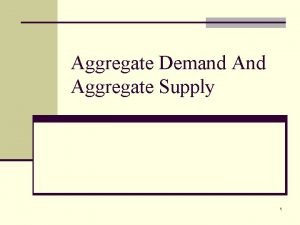Keynesian Macroeconomics Aggregate Demand the Multiplier Effect John











- Slides: 11

Keynesian Macroeconomics: Aggregate Demand the Multiplier Effect • John Maynard Keynes, The General Theory of Employment, Interest and Money (1936) • Great Depression (1929 -1938) shows possibility of underemployment equilibrium -actual GDP had not been equal to potential for years. • The Keynesian model distinguishes: – Actual GDP -- what GDP happens to be right now – Potential GDP -- full employment GDP – Equilibrium GDP -- a level of GDP at which there are no forces tending to change the level of GDP.

John Maynard Keynes, 1919 and 1945

The Keynesian system: Planned and actual investment Investment has three components: • Plant and equipment -- drill presses, factory buildings, etc. • Residential investment -- new housing construction • Inventory investment -- Change in Business Inventories The first two are consciously planned (although plans can change, and typically do during a recession); inventory investment can be unplanned -- if a store fails to sell what it had expected to, it winds up with more inventory than it had expected. Stores with unplanned inventory investment will cut back on orders -resulting in reduced production at the factory, layoffs and recession.

The Consumption Function: the key to Keynes Consumption depends on the level of DISPOSABLE INCOME (disposable personal income = income - taxes = Y - T) Some consumption is autonomous (= “independent” of DPI): it may depend on other factors such as wealth or stock values. (even at zero income, Bill Gates would consume something) The consumption function proposed by Keynes is: C = C 0 + Cy ( Y - T) C 0 = Autonomous consumption Cy = Marginal propensity to consume The marginal propensity to consume plays a central role in the Keynesian system. Keep your eye on the MPC in the following slides.

Income (DPI = Disposable Personal Income) and Consumption (PCE = Personal Consumption Expenditures) (U. S. , 1960. Q 1 to 2001. Q 3, data from FRED: Federal Reserve Economic Data

Regression line: PCE = - 71. 23 + 0. 93 DPI

The Keynesian model: National income identity and equilibrium The National income identity is: Y = C + I + G + NX The Keynesian equilibrium equation is: Y = C 0 + Cy ( Y - T) + Ip + G + NX Notice that C has been replaced by the consumption function, and investment by planned investment. Given values for autonomous consumption = 300 for the marginal propensity to consume = 0. 8 for planned investment = 1500 and finally for G = 1200, T = 1000, and NX = 500 the equation can be solved for Y.

Keynesian equilbrium: Solution procedure Start with the equation in general form: Y = C 0 + Cy ( Y - T) + Ip + G + NX Substitute in the given numbers: Y = 300 + 0. 8 ( Y - 1000) + 1500 + 1200 + 500 Collect all the constant terms: Y = 3500 + 0. 8 Y - 800 Y = 2700 + 0. 8 Y Subtract 0. 8 Y from both sides of the equation: 0. 2 Y = 2700 Finally, multiply both sides by 1 / 0. 2 = 5 Y = 5 (2700) = 13, 500

The Multiplier Rerun the previous exercise, raising planned investment by 500. Y = 300 + 0. 8 ( Y - 1000) + 2000 + 1200 + 500 Collect all the constant terms: Y = 4000 + 0. 8 Y - 800 Y = 3200 + 0. 8 Y Subtract 0. 8 Y from both sides of the equation: 0. 2 Y = 3200 Finally, multiply both sides by 1 / 0. 2 = 5 Y = 5 (3200) = 16, 000 GDP is UP BY 2, 500, NOT up by only 500. Investment spending has a MULTIPLIER EFFECT of 5

The Multiplier: Government Spending and Net Exports Instead of raising planned investment by 500, as on the last slide: • Raise Government Spending by 500 • Raise Net Exports by 500 • Cut taxes by 500 What happens in each case? You should find that the increases in government spending and in investment raise income by 2, 000 -- that the multiplier for investment, government spending and net exports is exactly the same. Hence the major policy proposals made by Keynes: -- raise government spending to expand the economy. -- ensure stability in the world trading system (IMF, WTO)

The Tax Multiplier Tax cuts have a multiplier effect, but not the same effect as direct government spending. Reason: part of any tax cut is saved, not spent. Consider the tax cut of 500: Y = 300 + 0. 8 ( Y - 500) + 1500 + 1200 + 500 Collect all the constant terms: Y = 3500 + 0. 8 Y - 400 or Y = 3100 + 0. 8 Y Subtract 0. 8 Y from both sides of the equation: 0. 2 Y = 3100 Finally, multiply both sides by 1 / 0. 2 = 5 Y = 5 (3100) = 15, 500 GDP is UP BY 2, 000, NOT up by 2, 500 as with investment. Tax cut has a MULTIPLIER EFFECT of 4. 0 ( not 5. 0 )
 New classical macroeconomics
New classical macroeconomics New classical and new keynesian macroeconomics
New classical and new keynesian macroeconomics Sras lras
Sras lras Ad curve graph
Ad curve graph Aggregate supply shifters
Aggregate supply shifters Tax multiplier formula
Tax multiplier formula Unit 3 aggregate demand aggregate supply and fiscal policy
Unit 3 aggregate demand aggregate supply and fiscal policy Tableau cannot mix aggregate and non aggregate
Tableau cannot mix aggregate and non aggregate Nicepp
Nicepp Crowding out effect macroeconomics
Crowding out effect macroeconomics Crowding out effect macroeconomics
Crowding out effect macroeconomics Crowding out definition ap macro
Crowding out definition ap macro




















